You are using an out of date browser. It may not display this or other websites correctly.
You should upgrade or use an alternative browser.
You should upgrade or use an alternative browser.
I believe I have a very special rifle
- Thread starter Snakeoil
- Start date
richhodg66
Well-Known Member
I have often wondered why the Bee never acheived the popularity level of the Hornet. It's inherently a better cartridge.
I have several .224 molds, been a back burner project to cast up a whole linotype ingot into bullets for the Hornet and Bee and not have to worry about casting for them probably until the dirt nap. A little lead goes a long way in the little ones.
A few moths ago, I got a good deal at a gun show on a few pounds of still sealed 680 which everyone says is the best thing going in the Hornet and Bee. I need to pursue this further. This damn earning a living thing sure does cut into my time for important stuff like casting and shooting
I have several .224 molds, been a back burner project to cast up a whole linotype ingot into bullets for the Hornet and Bee and not have to worry about casting for them probably until the dirt nap. A little lead goes a long way in the little ones.
A few moths ago, I got a good deal at a gun show on a few pounds of still sealed 680 which everyone says is the best thing going in the Hornet and Bee. I need to pursue this further. This damn earning a living thing sure does cut into my time for important stuff like casting and shooting
Missionary
Well-Known Member
With that 1-16 I would for sure start with the short cast bullets.
Glaciers
Alaska Land of the Midnight Sun
As hard as it is to get 218 Bee and 25-20 brass this will be the first bit of advice I follow. Back 40 years ago when I loaded the 218, brass was cheap and available at most LGS so It wasn’t worth the hassle. But times change. I’ll be taking care of these little pieces of gold, sorry brass.Consider annealing your brass right off the bat. I've found all brass in the 32/20 family seem to need annealing on a regular basis, even the superior Starline brass.
Good to hear that another vote for WW 680, I have had 4 pounds sitting on the shelf since I last owned a Bee. Is yours the 680 BR or the later 680 without the BR In the name?I have often wondered why the Bee never acheived the popularity level of the Hornet. It's inherently a better cartridge.
I have several .224 molds, been a back burner project to cast up a whole linotype ingot into bullets for the Hornet and Bee and not have to worry about casting for them probably until the dirt nap. A little lead goes a long way in the little ones.
A few moths ago, I got a good deal at a gun show on a few pounds of still sealed 680 which everyone says is the best thing going in the Hornet and Bee. I need to pursue this further. This damn earning a living thing sure does cut into my time for important stuff like casting and shooting
The 36 grain slick and the 47 grain I cast up Wednesday are going to be powder coated. These are to be run pretty slow maybe 1400 or so. Probably have to use Red Dot to get that slow. If the 47 grain Arsenal I have is to stabilize, I’m thinking COWW powder coated and run fairly fast.With that 1-16 I would for sure start with the short cast bullets.
The 36 grain is .40 inches and the 47 grain is .52 inches long. Both are shorter then the 55 FMJ that’s listed in the Speer #9 for the 1-16 Hornet. But there’s only one way to find out, sadly it’s going to be a while before I can do any testing.
Edit: forgot to include a picture of those two little bullets
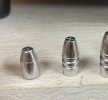
Last edited:
Snakeoil
Well-Known Member
Everything I've read said several things played a role in the lackluster history of the Bee. First, Winchester debuted the cartridge in a lever action rifle. About the same time, the .222 and Hornet arrived on the stage, thus diluting the impact of the Bee. Then WWII came along and all the varmint stuff pretty much ground to a halt. After the war, there were other choices and by then the .222 had proven itself to be a superior cartridge.
Regarding annealing, I appreciate that tip. the brass is new Hornady. I assume the problem is neck splits. I am thinking about breach seating with this rifle. That would preclude sizing in the reloading process and cases would probably last forever. We'll see.
I agree, 16 twist does not want a long bullet.
Regarding annealing, I appreciate that tip. the brass is new Hornady. I assume the problem is neck splits. I am thinking about breach seating with this rifle. That would preclude sizing in the reloading process and cases would probably last forever. We'll see.
I agree, 16 twist does not want a long bullet.
Bret4207
At the casting bench in the sky. RIP Bret.
Also consider the Hornet got a tremendous head start, was chambered in a lot of '03 Springfields, M54 Winchesters and other higher class rifles, plus the Savage 23, a buncha single shots, etc. The Bee got the Winchester lever gun, the Win 43 and ......... It's like asking why the 22 Zipper didn't take off. Lever gun with top ejection for a varmint cartridge! The few Marlins would have helped, but that was in the day of externally adjusted scopes for higher powers. And yeah, once the 222 came along, both cartridges got the kiss of death.
richhodg66
Well-Known Member
I believe the .222 came around about 1950 with the 722? I agree it would definitely render the others obsolete, but wasn't that a long time after the Bee and Hornet were around.
RicinYakima
High Steppes of Eastern Washington
Savage 23D in 1933 first commercial Hornet. Winchester made lever Bees in 1937.
Snakeoil
Well-Known Member
Yes, you are right. .22 Hornet was around first. Then came the Bee. But WWII killed varmint shooting for the most part and it did not resume until after the war. .222 showed up in 1950 as you said. I just looked up all the dates and see that my chronology was definitely off. .222 was definitely the final nail in the coffin for the Bee and probably the Hornet as well.I believe the .222 came around about 1950 with the 722? I agree it would definitely render the others obsolete, but wasn't that a long time after the Bee and Hornet were around.
As a sidenote, my Dad was in Abercrombie and Fitch in NYC sometime in the '60's. He spent a lot of time in their gun room. But he saw a rifle in there that he could not figure out why it was ever made. It was a very find double rifle in .22 Hornet. Probably still for sale today.
richhodg66
Well-Known Member
Though I have limited loading and shooting experience with the .222 (only rifle is a Savage 340), I am convinced it is the best of the .22 centerfires. Besides the Bee and Hornet, it completely killed the .219 Donaldson Wasp, which ruled the roost on the varmint and bench rest hooting circles prior to the .222 I'm told.
The Bee is a neat little cartridge, though. Seems like it should have done better.
The Bee is a neat little cartridge, though. Seems like it should have done better.
RicinYakima
High Steppes of Eastern Washington
Well, it has lived over 80 years in single shot rifles, and is loved by those that have them.Though I have limited loading and shooting experience with the .222 (only rifle is a Savage 340), I am convinced it is the best of the .22 centerfires. Besides the Bee and Hornet, it completely killed the .219 Donaldson Wasp, which ruled the roost on the varmint and bench rest hooting circles prior to the .222 I'm told.
The Bee is a neat little cartridge, though. Seems like it should have done better.
Rick H
Well-Known Member
I was competitive with the local benchrest crowd with a box stock Remington 700 BDL Varmint Special in .222Rem. I loaded it with a Lee Target Loader (yes, a souped up Whack-a Mole) and IMR-4198 behind 53gr. Hornady HP's. Registered and scored .25" groups or less at 100yds if I read the wind right. The 222Rem is a great well balanced and accurate cartridge. I still regret the day I let my boss talk me out of that rifle.
Today I own nary a one....but 5 different .223/5.56 rifles. It is very hard to dismiss the advantages of the current military issue cartridge. The .223 is no slouch in accuracy either. The military's adoption of the M-16 and the .223/5.56 was the death knell of the .222.
May all the old great cartridges live a long life. They work just as well today as they ever did.
Today I own nary a one....but 5 different .223/5.56 rifles. It is very hard to dismiss the advantages of the current military issue cartridge. The .223 is no slouch in accuracy either. The military's adoption of the M-16 and the .223/5.56 was the death knell of the .222.
May all the old great cartridges live a long life. They work just as well today as they ever did.
Bret4207
At the casting bench in the sky. RIP Bret.
222 is hard to find these days, and that is something that was unimaginable to me back in the day. I'd still prefer it to the 223 if I had a small action bolt gun, just for familiarity's sake I suppose.
Those wanting to get a line on how things were in the varmint/small game circles back in the 20's/30's/40's should look up a copy of "Hunting with the Twenty-Two" by Charles S, Landis. Wonderful book! I've read my copy dozens of times. There are several other books from the period worth reading too. In that era, a rifle that would hold a 1.5" group reliably was a treasure!
Those wanting to get a line on how things were in the varmint/small game circles back in the 20's/30's/40's should look up a copy of "Hunting with the Twenty-Two" by Charles S, Landis. Wonderful book! I've read my copy dozens of times. There are several other books from the period worth reading too. In that era, a rifle that would hold a 1.5" group reliably was a treasure!
Bret4207
At the casting bench in the sky. RIP Bret.
And the 222 Mag. That one was all the rage for close to 20 years.I was competitive with the local benchrest crowd with a box stock Remington 700 BDL Varmint Special in .222Rem. I loaded it with a Lee Target Loader (yes, a souped up Whack-a Mole) and IMR-4198 behind 53gr. Hornady HP's. Registered and scored .25" groups or less at 100yds if I read the wind right. The 222Rem is a great well balanced and accurate cartridge. I still regret the day I let my boss talk me out of that rifle.
Today I own nary a one....but 5 different .223/5.56 rifles. It is very hard to dismiss the advantages of the current military issue cartridge. The .223 is no slouch in accuracy either. The military's adoption of the M-16 and the .223/5.56 was the death knell of the .222.
May all the old great cartridges live a long life. They work just as well today as they ever did.
richhodg66
Well-Known Member
On my bucket list is to have a nice, .222 on some kind of diminutive bolt action, been watching Sakos on gunbroker for a while, eventually I'll pull the trigger on one.
Had a friend at the gun club when I was growing up, about my Dad's age. The guy farmed, but was one of these guys who was just plain steady as a rock when it came to shoot under any kind of field conditions and the nature of his work had him outside all the time. He had one rifle, a Remington 722 in .222 he used for everything, he'd bought it new and used almost nothing else. The guy fed his family on deer shot with it, never took anything but the base of the skull shot and when he pulled the trigger the deer was as good as dead. He was and could afford to be picky about the shots he took.
That was kind of what got me in the mind set that the .222 is a wonder cartridge, but it's so darn efficient and that long neck sure helps.
Had a friend at the gun club when I was growing up, about my Dad's age. The guy farmed, but was one of these guys who was just plain steady as a rock when it came to shoot under any kind of field conditions and the nature of his work had him outside all the time. He had one rifle, a Remington 722 in .222 he used for everything, he'd bought it new and used almost nothing else. The guy fed his family on deer shot with it, never took anything but the base of the skull shot and when he pulled the trigger the deer was as good as dead. He was and could afford to be picky about the shots he took.
That was kind of what got me in the mind set that the .222 is a wonder cartridge, but it's so darn efficient and that long neck sure helps.
Snakeoil
Well-Known Member
I was going to put this in whatchya doin' today, but thought it really deserved to be part of this thread.
I have a great appreciation for the Lee neck sizing collet dies. I do not own multiple rifles in the same caliber so the need for full-length resizing is not necessary for me.
Enter the .218 Bee. I ordered the Lee 3 die set in .218 B and since they don't offer a collet necksizing die in that caliber, I ordered one in .22 Hornet.
The ID and OD of both cartridges is identical. The differences are the shoulder angle, the length of the neck, the OAL of the case and of course, the body diameters. The collet dies only care about OAL of the case, neck ID and OD, the shoulder angle and the length of the neck.
The Bee is shorter than the Hornet on both OAL and neck length. This means that the Hornet die must be modified to use with the Bee case. Nice thing is it is easy to figure out by fudging. You put a washer on top of the shell holder in the press after you slip a case into the holder. The washer will contact the closing collet sooner, thus making it work with the Bee case. You can change the thickness of the washer until you get what you want. Then you can measure things to confirm.
Of course, I thought there might be the possibility that no modification would be necessary, and I slipped a case into the shell holder and ran it up into the die lightly. When it came out, the shoulder had been pushed back. So, that gave me a measure of how thick the collet had to be lengthened. Without the spacer, the case is pushing the collet up, but is weak so it gives, and the shoulder moves back until the shell holder makes contact and then the collet closes and sizes the neck. Of course, I did not figure that all out on the first try. Gray hair has slowed down my ability to visualize what is doing on inside of mechanical devices and I crunched another 3 new cases in the learning/testing process.
Since you cannot see what is going on inside the die, I did remove the closer and the mandrel and ran the case up into the collet until it touched to see how far the shell holder was from the collet. Dug thru my misc washer drawer and an old spark plug washer did the trick. It measured 0.050". But putting a washer over every case to be deprimed and sized is a PITA and runs a high risk that the gray-haired operator will forget and push the shoulder back on the case or two... or ten. So, the die had to be modified.
Now, you might be thinking, "Gee the Hornet is longer than the Bee. Shouldn't the die have to be shortened?". The answer is no. The neck on the Hornet is longer but from the case base to where the neck begins, the Hornet is shorter by 0.080" compared to the Bee. This is why the shoulder crashed into the bottom of the sizing section on the collet with a Bee case. And, difference in the base to start of neck location is greater than the difference in OAL of the cases.
Here is a picture of two Bee cases. One on the left is per spec and the other on the right shows the shoulder pushed back after crashing into the bottom of the collet sizing section.
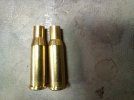
Here are a couple pics of a good case and a damaged case in the same collet. It is subtle, but you can see that the damaged case is deeper in the collet. Damaged case on left, good case on the right. The other thing to keep in mind is that the collet is open. When it closes, it will crunch a bit of the shoulder where it transitions to the neck. So, you cannot have the neck butting tight to the bottom of the sizing area inside the collet.
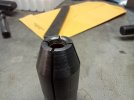
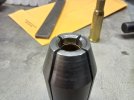
Measuring the depth of the case mouths from the top face of the collet above gave 0.090" for the damaged case and 0.150" for the good case. That means I need a 0.060" spacer... kinda. Remember, the collet is open. I'm not sure how much more clearance I need for a good case not to crunch the shoulder. And, these are all new cases. OAL might vary from case to case. I could measure, but I have already damaged 4 cases so I was not willing to crunch any more. But I found another way.
Here is the mod I made to the die. I took a generic steel washer, soldered it to the bottom of the collet and then machined the ID and OD to be flush with the collet walls. The spacer thickness is approximately 0.075" including the solder joint. Yes, that is more than I need based upon the above dimensions. But remember that I said that the collet was open when I took those measurements. So, another 0.015" gives some added clearance for the shoulder inside the collet at the bottom of the sizing area.
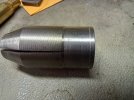
When the mod was done, I put the die back into the press and put a good case in and ran it thru the size. It came out perfect.
So, to confirm, I pulled the closer and mandrel out of the die. I took another new case and put it in the collet. From the mouth to the top of the collet I measured 0.095". Then, I put that same case in the press and ran the case back up into the collet with the closer and mandrel removed and measured that same distance. I measured 0.140. Here's the view. The end of my caliper just fit inside the die. So, I have 0.055" of play. Might need that after these are fire-formed to my chamber.
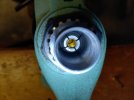
So, I now have a .218 Bee collet neck sizing die. Of course, none of these cases have been fired and formed to my chamber. Those 4 damaged cases should fire form back to the correct shoulder config. Once all the cases have been formed to the chamber, I'll revisit this subject to be sure the shoulder is not going to butt up against the bottom of the collet. I think I'll be okay. But only testing will tell. Once all that is done, the cases will all get trimmed to the same length.
Another nice feature of the new Lee collet dies is they do not resize the very top of the neck. I was going to make an M-die for the Bee, but I tried both a GC bullet and a PB bullet and both slip into the first .030 or so of the neck like they would with an M-die. So, it looks like I'll not need the M-die step when I reload the cases. It will simply be deprime/neck size, clean the pockets and prime, fill with powder and seat a bullet. If I decide to breach seat, seating the bullet will be replaced with cap the neck with florist foam.
I have a great appreciation for the Lee neck sizing collet dies. I do not own multiple rifles in the same caliber so the need for full-length resizing is not necessary for me.
Enter the .218 Bee. I ordered the Lee 3 die set in .218 B and since they don't offer a collet necksizing die in that caliber, I ordered one in .22 Hornet.
The ID and OD of both cartridges is identical. The differences are the shoulder angle, the length of the neck, the OAL of the case and of course, the body diameters. The collet dies only care about OAL of the case, neck ID and OD, the shoulder angle and the length of the neck.
The Bee is shorter than the Hornet on both OAL and neck length. This means that the Hornet die must be modified to use with the Bee case. Nice thing is it is easy to figure out by fudging. You put a washer on top of the shell holder in the press after you slip a case into the holder. The washer will contact the closing collet sooner, thus making it work with the Bee case. You can change the thickness of the washer until you get what you want. Then you can measure things to confirm.
Of course, I thought there might be the possibility that no modification would be necessary, and I slipped a case into the shell holder and ran it up into the die lightly. When it came out, the shoulder had been pushed back. So, that gave me a measure of how thick the collet had to be lengthened. Without the spacer, the case is pushing the collet up, but is weak so it gives, and the shoulder moves back until the shell holder makes contact and then the collet closes and sizes the neck. Of course, I did not figure that all out on the first try. Gray hair has slowed down my ability to visualize what is doing on inside of mechanical devices and I crunched another 3 new cases in the learning/testing process.
Since you cannot see what is going on inside the die, I did remove the closer and the mandrel and ran the case up into the collet until it touched to see how far the shell holder was from the collet. Dug thru my misc washer drawer and an old spark plug washer did the trick. It measured 0.050". But putting a washer over every case to be deprimed and sized is a PITA and runs a high risk that the gray-haired operator will forget and push the shoulder back on the case or two... or ten. So, the die had to be modified.
Now, you might be thinking, "Gee the Hornet is longer than the Bee. Shouldn't the die have to be shortened?". The answer is no. The neck on the Hornet is longer but from the case base to where the neck begins, the Hornet is shorter by 0.080" compared to the Bee. This is why the shoulder crashed into the bottom of the sizing section on the collet with a Bee case. And, difference in the base to start of neck location is greater than the difference in OAL of the cases.
Here is a picture of two Bee cases. One on the left is per spec and the other on the right shows the shoulder pushed back after crashing into the bottom of the collet sizing section.

Here are a couple pics of a good case and a damaged case in the same collet. It is subtle, but you can see that the damaged case is deeper in the collet. Damaged case on left, good case on the right. The other thing to keep in mind is that the collet is open. When it closes, it will crunch a bit of the shoulder where it transitions to the neck. So, you cannot have the neck butting tight to the bottom of the sizing area inside the collet.


Measuring the depth of the case mouths from the top face of the collet above gave 0.090" for the damaged case and 0.150" for the good case. That means I need a 0.060" spacer... kinda. Remember, the collet is open. I'm not sure how much more clearance I need for a good case not to crunch the shoulder. And, these are all new cases. OAL might vary from case to case. I could measure, but I have already damaged 4 cases so I was not willing to crunch any more. But I found another way.
Here is the mod I made to the die. I took a generic steel washer, soldered it to the bottom of the collet and then machined the ID and OD to be flush with the collet walls. The spacer thickness is approximately 0.075" including the solder joint. Yes, that is more than I need based upon the above dimensions. But remember that I said that the collet was open when I took those measurements. So, another 0.015" gives some added clearance for the shoulder inside the collet at the bottom of the sizing area.

When the mod was done, I put the die back into the press and put a good case in and ran it thru the size. It came out perfect.
So, to confirm, I pulled the closer and mandrel out of the die. I took another new case and put it in the collet. From the mouth to the top of the collet I measured 0.095". Then, I put that same case in the press and ran the case back up into the collet with the closer and mandrel removed and measured that same distance. I measured 0.140. Here's the view. The end of my caliper just fit inside the die. So, I have 0.055" of play. Might need that after these are fire-formed to my chamber.

So, I now have a .218 Bee collet neck sizing die. Of course, none of these cases have been fired and formed to my chamber. Those 4 damaged cases should fire form back to the correct shoulder config. Once all the cases have been formed to the chamber, I'll revisit this subject to be sure the shoulder is not going to butt up against the bottom of the collet. I think I'll be okay. But only testing will tell. Once all that is done, the cases will all get trimmed to the same length.
Another nice feature of the new Lee collet dies is they do not resize the very top of the neck. I was going to make an M-die for the Bee, but I tried both a GC bullet and a PB bullet and both slip into the first .030 or so of the neck like they would with an M-die. So, it looks like I'll not need the M-die step when I reload the cases. It will simply be deprime/neck size, clean the pockets and prime, fill with powder and seat a bullet. If I decide to breach seat, seating the bullet will be replaced with cap the neck with florist foam.
Last edited:
Glaciers
Alaska Land of the Midnight Sun
Well that’s good information as I was going to contact Lee and see what the cost for making a 218 Bee collet die. But I just happen to have a Hornet collet die as well.
So I will reread your post when I’m not so tired.
I certainly don’t want to waste any Bee brass.
Edit: I have NOE expanders available if there’s a need.
So I will reread your post when I’m not so tired.
I certainly don’t want to waste any Bee brass.
Edit: I have NOE expanders available if there’s a need.
Last edited:
